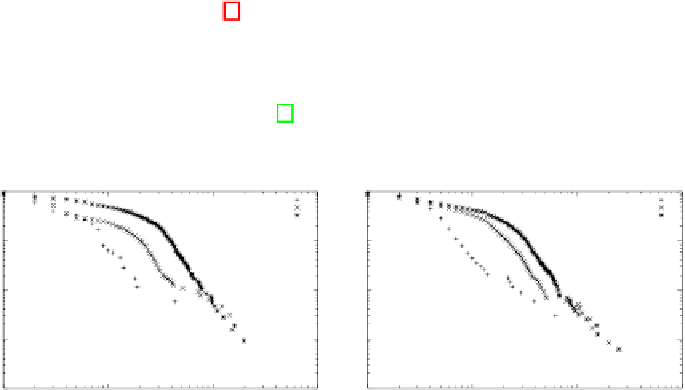Information Technology Reference
In-Depth Information
the right-hand plot of figure 3, which for all experiments stabilises to a low value.
One consequence of the growth model which includes death dynamics however is
that these hubs are transient, as observed by the spiking nature of the left-hand
plot of maximum degree vs iterations. The existence of hubs at all however is
contrary to the results found in [4] using an exogenous growth model without
death dynamics.
1
1
Upper limit 10,000
Upper Limit 100,000
Upper limit 200,000
Upper limit 10,000
Upper limit 100,000
Upper limit 200,000
0.1
0.1
p(k)
p(k)
0.01
0.01
0.001
0.001
Heterogeneous
Homogeneous
1e−04
1e−04
1
10
100
1000
1
10
100
1000
degree
degree
Fig. 4.
The graphs show the cumulative degree distribution P(k)for homogeneous and
heterogeneous networks for values of
u ∈
10
K,
100
K, and
200
K
. Distributions were
derived by taking at snapshot of the network at the instant when the maximum degree
was observed.
An understanding of the degree distribution in a graph can be obtained by
plotting the cumulative distribution function
P
(
k
)=
k
=
k
p
k
,where
p
k
is
the probability that a randomly chosen vertex will have degree
k
, and therefore
P
k
the probability that the degree is greater than or equal to
k
. In a random
graph, a binomial distribution of node degrees is observed; in real-world net-
works, and particularly biological networks, a power-law or scale-free distribu-
tion is observed. This shows up as a power-law in the cumulative distribution,
with
P
k
≈
k
−
(
α−
1)
, and is therefore easy to spot experimentally by plotting the
cumulative distributions on logarithmic scales. This is given for both homoge-
neous and heterogeneous networks in figure 4. These appear to show a truncated
power-law distribution in the tails of the graphs, particularly as
U
is increased,
though the distributions deviate from this law at small degree (or possibly two
separate power-laws contribute). Again, this is contradictory to the results of [4]
which show an exponential degree distribution for their exogenous production
model.
[4] found that hubs do occur when an endogenous birth-dynamics is used, due
to nodes of high concentration preferentially attaching to new nodes, in a model
where “the rich get richer”. The results we present however suggest that hubs do
exist — yet there is no preferential attachment to nodes of high degree (as in the
Barabasi
et al
's model, or to nodes of high concentration as in [4]. Figure 5 plots
the relationship between concentration and degree in Bersini model. This shows
an inverse correlation between degree and concentration, which is in fact opposite
to that presented in [4] using the endogenous production dynamics. Again, the
explanation lies partly in equation 1 — nodes with high degree receive a high






